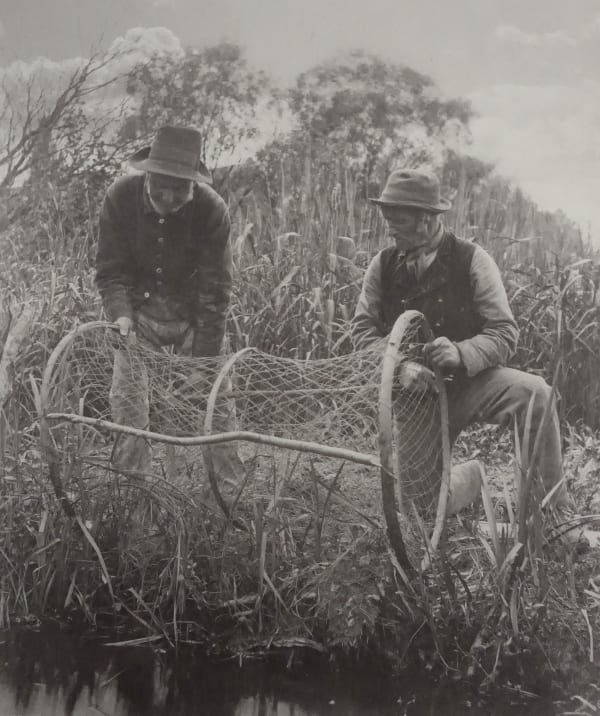P. H. Emerson (1856 - 1936) was an English photography pioneer, renowned for capturing the life and landscapes of East Anglia’s agrarian community. His vocal advocacy for ‘truthful’ photography as an art form saw him rise to a celebrated and sometimes controversial position of influence within the contemporary photographic establishment.
-
Peter Henry Emerson was born in Cuba and moved to England at the age of 13 to attend boarding school. Originally introduced to photography on bird-watching trips, Emerson became a founding member of the Camera Club of London in 1885, before being elected to the Council of the Royal Photographic Society in the following year. He continued to write about photography, publishing a number of albums and treaties, throughout the rest of his life. Emerson has been the subject of numerous solo exhibitions and his photography is held in the permanent collections of the Victoria & Albert Museum, London, the Museum of Modern Art, New York, and the Getty Museum, Los Angeles.
-
 P. H. EmersonTaking up the Eel-Net, 1886Vintage platinum printImage 28 x 18.8 cms
P. H. EmersonTaking up the Eel-Net, 1886Vintage platinum printImage 28 x 18.8 cms
Sheet 41.2 x 28.9 cmsThis exhibition focuses on a selection of images taken from Life and Landscape on the Norfolk Broads (1886) and Marsh Leaves (1895), which exemplify Emerson’s vision of the English pastoral. It has been organised in conjunction with renowned 19th Century photography specialist Robert Hershkowitz.
-
Emerson's pictures illustrate traditional ways of life - cutting reeds, casting nets, hunting snipe - against a shifting backdrop of water and sky. In his reverence for rural landscapes and his admiration of the agrarian legacy perpetuated by its inhabitants, Emerson was drawn to the earlier generation of French Naturalist artists. Less than three decades after the painters of the Barbizon school had embraced painting from life en plain air, Emerson set out to capture his own rural idyll with the same commitment to artistic truthfulness.
-
-
Emerson’s understanding of what this truthful perspective constituted evolved considerably over the course of his career. His interest in photography was founded on the belief that any medium could only attain artistic dignity by remaining faithful to its inherent nature, which in the case of photography was its mechanical capacity to replicate scenes in with a unique degree of detail. The clarity and precision of his early platinum prints testify to Emerson’s desire to use the camera to sensitively render these scenes with accuracy.
However, as Emerson became more interested in contemporary optical theories, his perspective literally shifted. Recent research showed that the human eye only registered objects of attention in sharp focus, with other details fading into softer definition.
-
 P. H. EmersonA Norfolk Boat Yard, 1886Vintage platinum printImage 28.9 x 24.7 cms
P. H. EmersonA Norfolk Boat Yard, 1886Vintage platinum printImage 28.9 x 24.7 cms
Sheet 41.4 x 28.9 cms -
Emerson continued to explore the fundamental dynamics of the camera and to hypothesise about photography’s future. He published eight albums over the course of the next decade, experimenting with new printing techniques and technological innovations, but consistently returning to his fascination with Norfolk. After the success of Marsh Leaves (1895), Emerson published no further pictures, instead choosing to focus on his writing.
Emerson is perhaps most famous today for his defence of photography as an art form during the intense period of debate which followed this new medium’s emergence in the second half of the 19th century. Whilst strongly opposed to the artificiality of composite prints and manipulated negatives, Emerson’s conception of photography balanced aesthetic desire with aspirations towards truthfulness. The anonymous reviewer of Marsh Leaves, who in 1897 described its pictures as ‘photographic gems’, has grasped the delicacy of Emerson’s twin ideals and the subtle success of this approach.
-
FEATURED WORKS
-

P. H. Emerson
Gathering Water Lillies, 1886This picture, taken from Emerson's first series of photographs, Life and Landscape on the Norfolk Broads (1886), exemplifies his early interest in reproducing scenes of beauty from quotidian rural life with a precision and clarity previously unattainable in other art forms. Emerson chose to create this image as a platinum print, which granted him the most expansive and sensitive range of tonal variation for rendering the delicate details of the lillies floating on the water. These prints are made by coating a paper surface with platinum and ferric oxalate before exposure to a light source, after which unreacted materials are dissolved out in clearing baths which ‘fix’ the image. Another benefit of this process is the longevity of platinum prints, so that each aspect of these pictures remains as clear and sharp, after more than a century, as when Emerson first took them.
-

P. H. Emerson
A Winter Pastoral, 1895In his most famous series, Marsh Leaves (1895), Emerson turned away from trying to capture the people of East Anglia, to focus almost exclusively on the landscapes and horizons so characteristic of this region. He also embraced an alternative mode of print production, choosing gravures which are made by engraving the impression of the desired image into a plate or cylinder which is then coated with ink and printed. In his attempt to replicate the experience of the eye and his renewed enthusiasm for landscapes, Emerson's focus softened and broadened, to encompass wider vistas in a gentler relief. Without loosing any of the subtle variation which had become as a hallmark of his photography, Emerson's last major body of work is inculcated with a new softness and tranquility,
-
AVAILABLE WORKS
-
-
gallery exhibition CURATED BY ROBERT HERSHKOWITZ
VIEWING ROOM BY cARYS lake-Edwards with TEXT BY LUCY FLEMING-BROWN

























